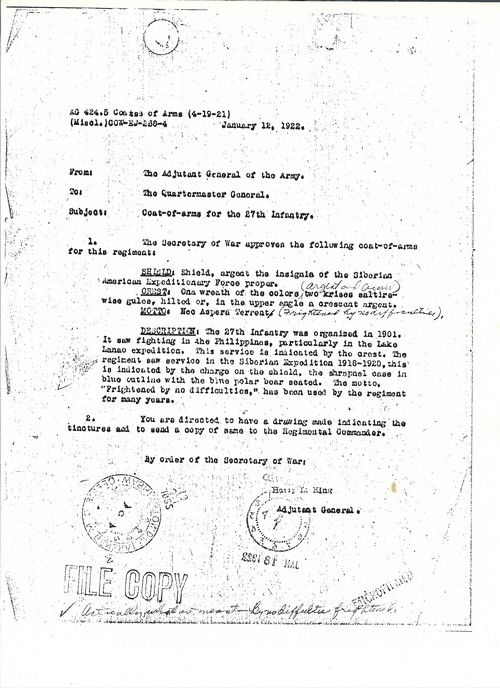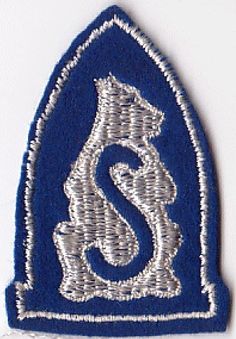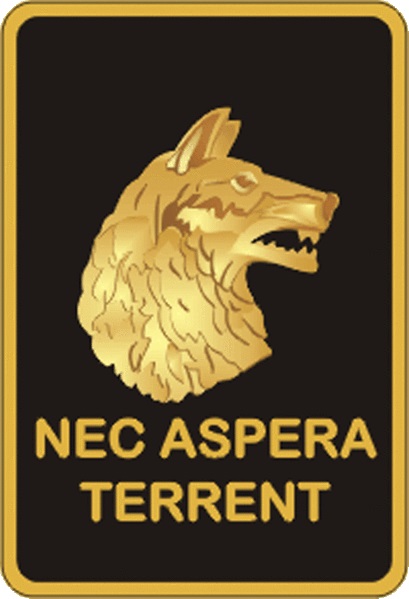A Brief History of the 27th Regiment
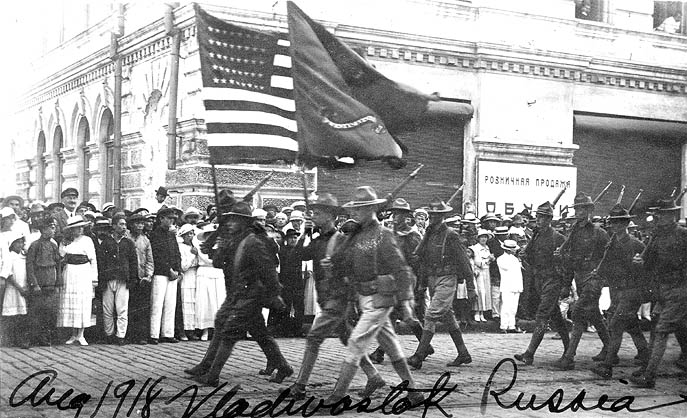
The 27th Infantry was activated 12 February 1901 into the Regular Army at Fort McPherson, Georgia. In December, the Regiment deployed to the Philippines to defeat Moro insurgents on the island of Mindanao. After the Moros' defeat, the Regiment deployed to Camp Sheridan, Illinois, in 1904.
After service in Cuba, Texas, and again in the Philippines, the Regiment sailed to Vladivostok, Siberia, in 1918, as part of the Allied Expeditionary Force. One of their missions was to guard the Trans-Siberian Railroad, which often resulted in combat with communist Bolsheviks. While in Russia, the Regiment earned its nickname "The Wolfhounds," because of its aggressive pursuit of retreating Bolshevik forces.
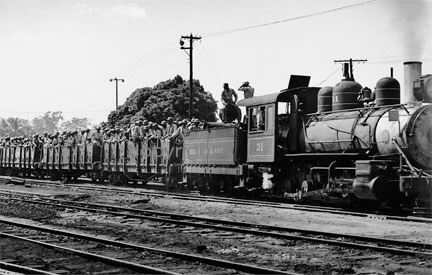
In 1921, after brief stays in Japan and the Philippines, the Wolfhounds made their home at Schofield Barracks, Territory of Hawaii, where they earned an enviable reputation in training and athletic prowess. In October 1941, the Royal Hawaiian Division was broken down into the 24th and 25th Infantry Division. The Wolfhounds were assigned to the 25th Division. On 7 December 1941, Wolfhounds fought back against Japanese aircraft from its D-Quad rooftops. As part of the Tropic Lightning Division, the 1st Wolfhounds fought through the Southwest Pacific at Guadalcanal, the Northern Solomons, and finally, the island of Luzon in the Philippines, where the Regiment earned a Philippine Presidential Unit Citation.
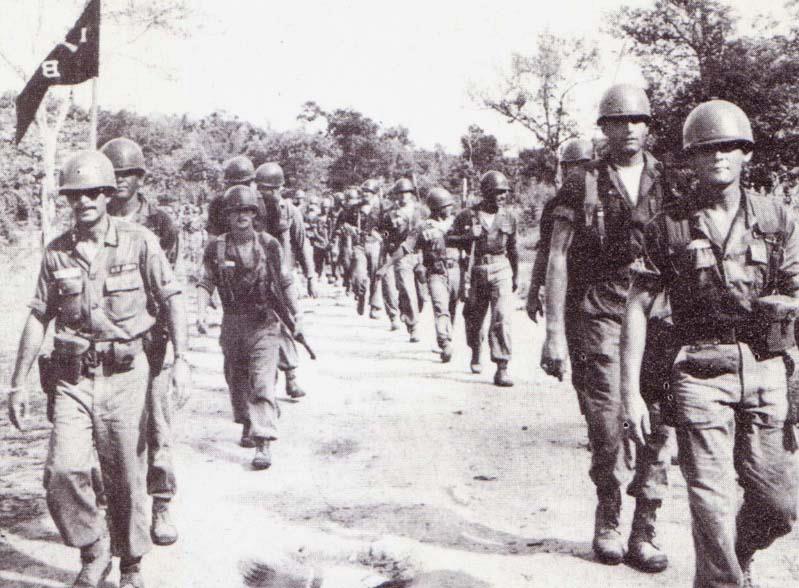
After World War II, the Regiment served as occupational forces in Japan. They earned their nickname "Gentle Wolfhounds" for their loving support of the Holy Family Orphanage in Osaka, which continues to this day.
In July 1950, the Regiment, as part of the 25th Infantry Division, deployed to South Korea to defeat the North Korean invasion. Their actions near SsangYong-Ni earned the first Presidential Unit Citation of the war. During the defense of the Pusan Perimeter, the Wolfhounds became known as the Eighth Army's "Fire Brigade" for their rapid and violent counterattacks. For the defense of Taegu, they earned a second Presidential Unit Citation. After the Chinese entered the war in late 1950, the Regiment earned its third Presidential Unit Citation for assaulting across the Han River, which culminated in the recapture of Seoul in April 1951. The Regiment redeployed to the Territory of Hawaii in 1954.
The First Wolfhounds arrived in South Vietnam in January 1966. During their five-year stay in Vietnam, the Wolfhounds were considered on of the 25th Infantry Division's most effective units, earning a Valorous Unit Citation in 1967. Primarily operating from Cu Chi in the Tay Ninh Province, the Battalion participated in Operation Attleboro, Cedar Fills, Junction City, the '68 and '69 Tet Offensives, and the 1970 invasion of Cambodia. One of the last of the 25th Infantry Division's units to depart Vietnam, the Wolfhounds arrived home in Hawaii in April, 1971.
Since their return to Oahu, they have deployed to Tinian, Guam, Korea, Thailand, Australia, and Japan, as well as the Training Centers in the continental United States. The Wolfhounds spearheaded the relief operations on hurricane-ravaged Kauai in September 1992. The Wolfhounds deployed to Guam for Operation Pacific Haven where they provided security for Kurdish refugees from October to December 1996.
On 10 June 1987, the 2nd Battalion was relieved from their assignment to the 25th Infantry Division and assigned to the 7th Infantry Division at Fort Ord, California. During their tour at Fort Ord, the 2nd & 3rd Battalions were deployed to Honduras in 1988 in support of Operation Golden Pheasant, and in 1989 they were deployed to Panama in support of Operation Just Cause. On September 15, 1993, the Battalion was inactivated and relieved from assignment to the 7th Infantry Division. The 2nd Battalion was again activated on 31 August 31 1995.
The 4th Battalion, 27th Infantry was active in the 3rd Brigade, 25th Infantry Division (L) at Schofield Barracks on the island of Oahu in Hawaii during the late 1980s and early 1990s. Also assigned to the 3rd Brigade was the 1st Battalion, 27th Infantry. Elements of 4th Battalion were deployed during Operation Desert Storm and served as guards for Gen. Norman Schwarzkopf during their deployment. They also participated in clearing operations in Kuwait and a security element for later peace talks.
Our Active Duty Wolfhounds are not currently deployed in a combat zone. More recently the Wolfhounds have conducted Expert Infantry Badge (EIB) Training, MOS Cross knife throwing, etc. and training with counterparts in Australia, Thailand, Korea, and Indonesia, keeping on the ready if called upon.
The Regiment proudly carries over twenty-nine battle streamers and more than eleven citations on its colors. Its motto, "NEC ASPERA TERRENT," translates to "FEAR NO DIFFICULTIES," but is commonly known as "NO FEAR ON EARTH".
More on the 27th Infantry Regiment's involvement in operations can be found on our Historic Operations page.
Coat of Arms and Distinctive Unit Insignia
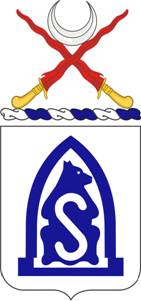
The order approving the 27th Infantry's coat-of-arms was given in January, 1922. A photocopy of the order is included below (click for an enlarged version). The order reads:
January 12, 1922
From: The Adjutant General of the Army.
To: The Quartermaster General.
Subject: Coat-of-arms for the 27th Infantry.
1. The secretary of War approves the following coat-of-arms for this regiment:
SHIELD: Shield, argent the insignia of the Siberian American Expeditionary Force proper.
CREST: On a wreath of the colors (argent and azure) two krises saltire-wise gules, hilted or, in the upper angle a crescent argent.
MOTTO: Nec Aspera Terrent (Frightened by no difficulties).
DESCRIPTION: The 27th Infantry was organized in 1901. It saw fighting in the Philippines, particularly in the Lake Lanao expedition. This service is indicated by the crest. The regiment saw service in the Siberian Expedition 1918-1920, this is indicated by the charge on the shield, the shrapnel case in blue outline with the bine polar bear seated. The motto, "Frightened by no difficulties," has been used by the regiment for many years.
2. You are directed to have a drawing made indicating the tinctures and to send a copy of same to the Regimental Commander.
By order of the Secretary of War:
Harry L. King
Adjutant General
Battalion Lineage and Honors
The documents below record the lineage and honors of the 1st and 2nd Battalions, 27th Infantry, as of June 2, 2010. This information comes from the U.S. Army Center of Military History.
A Lineage and Honors Certificate, or "Lineage," is a stylized outline history of a unit. The Lineage establishes the continuity of a unit through various changes in designation and status, thereby verifying the unit's entitlement to honors, as well as heraldic items, unit historical property and files, and other tangible assets.
More information on lineage and honors can be found here.
Grog Ceremonies
Here are two scripts for Wolfhound "Grog Ceremonies".
| Wolfhound Grog Ceremony (script 1) |
| Wolfhound Grog Ceremony (script 2) |

